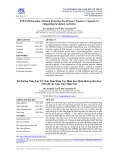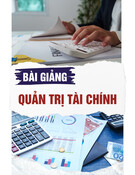
CHAPTER 30
Short-term Financial Planning
Answers to Practice Questions
1. Unless otherwise stated in the problem, assume all expenses are for cash.
February March April
Sources of cash
Collections on cash sales $100 $110 $90
Collections on A/R 90 100 110
Total sources of cash 190 210 200
Uses of cash
Payments on A/P 30 40 30
Cash purchases of materials 70 80 60
Other expenses 30 30 30
Capital expenditures 100 0 0
Taxes, interest, dividends 10 10 10
Total uses of cash 240 160 130
Net cash inflow -50 50 70
Cash at start of period 100 50 100
+ Net cash inflow -50 50 70
= Cash at end of period 50 100 170
+ Minimum operating cash balance 100 100 100
= Cumulative short-term
financing required $50 $0 $0
2. 30-Day Delay: This quarter it will pay 1/3 of last quarter’s purchases and 2/3 of
this quarter’s.
60-Day Delay: This quarter it will pay 2/3 of last quarter’s purchases and 1/3 of
this quarter’s.
34

3. a. Rise in interest rates: Interest payments on bank loan and interest on
marketable securities
b. Interest on late payments: Stretching payables; net new borrowing.
c. Underpayment of taxes: Cash required for operations.
(Bear in mind, however, that if any of these events were unforeseen, they would
not appear in the financial plan, which is constructed well in advance of the
beginning of the first quarter.)
4. Sources and Uses of Cash:
Sources
Sold marketable securities 2
Increased bank loans 1
Increased accounts payable 5
Cash from operations:
Net income 6
Depreciation 2
Total sources 16
Uses
Increased inventories 6
Increased accounts receivable 3
Invested in fixed assets 6
Dividend 1
Total uses 16
Increase in cash balance 0
Sources and Uses of Funds:
Sources
Cash from operations
Net income 6
Depreciation 2
Total sources 8
Uses
Invested in fixed assets 6
Dividend 1
Total uses 7
Increase in net working capital 1
35

5. The new plan is shown below:
First
Quarter
Second
Quarter
Third
Quarter
Fourth
Quarter
New borrowing:
1. Bank loan 41.50 8.50 0.00 0.00
2. Stretching payables 0.00 7.64 0.00 0.00
3. Total 41.50 16.14 0.00 0.00
Repayments:
4. Bank loan 0.00 0.00 16.59 33.41
5. Stretching payables 0.00 0.00 7.64 0.00
6. Total 0.00 0.00 24.23 33.41
7. Net new borrowing 41.50 16.14 -24.23 -33.41
8. Plus securities sold 5.00 0.00 0.00 0.00
9. Less securities bought 0.00 0.00 0.00 0.65
10. Total cash raised 46.50 16.14 -24.23 -34.06
Interest payments:
11. Bank loan 0.00 1.04 1.25 0.84
12. Stretching payables 0.00 0.00 0.43 0.00
13. Interest on
securities sold 0.00 0.10 0.10 0.10
14. Net interest paid 0.00 1.14 1.78 0.94
15. Cash required for
operations 46.50 15.00 -26.00 -35.00
16. Total cash required 46.50 16.14 -24.23 -34.06
36

6.
First
Quarter
Second
Quarter
Third
Quarter
Fourth
Quarter
Sources of cash:
Collections on A/R 85.0 80.3 108.5 128.0
Other 0.0 0.0 12.5 0.0
Total sources 85.0 80.3 121.0 128.0
Uses of cash:
Payments on A/P 65.0 60.0 55.0 50.0
Labor, administrative, other 30.0 30.0 30.0 30.0
Capital expenditures 2.5 1.3 5.5 8.0
Lease 1.5 1.5 1.5 1.5
Taxes, interest, dividends 4.0 4.0 4.5 5.0
Total uses 103.0 96.8 96.5 94.5
Sources - uses -18.0 -16.5 24.5 33.5
Calculation of short-term financing requirement
1. Cash at start of period 5.0 -13.0 -29.5 -5.0
2. Change in cash balance -18.0 -16.5 24.5 33.5
3. Cash at end of period -13.0 -29.5 -5.0 28.5
4. Min. operating cash bal. 5.0 5.0 5.0 5.0
5. Cumulative short-term
financing required.
18.0 34.5 10.0 -23.5
37

First
Quarter
Second
Quarter
Third
Quarter
Fourth
Quarter
New borrowing:
1. Bank loan 13.00 16.93 0.00 0.00
2. Stretching payables 0.00 0.00 0.00 0.00
3. Total 13.00 16.93 0.00 0.00
Repayments:
4. Bank loan 0.00 0.00 22.81 7.12
5. Stretching payables 0.00 0.00 0.00 0.00
6. Total 0.00 0.00 22.81 7.12
7. Net new borrowing 13.00 16.93 -22.81 -7.12
8. Plus securities sold 5.00 0.00 0.00 0.00
9. Less securities bought 0.00 0.00 0.00 26.10
10. Total cash raised 18.00 16.93 -22.81 -33.22
Interest payments:
11. Bank loan 0.00 0.33 0.75 0.18
12. Stretching payables 0.00 0.00 0.85 0.00
14. Interest on
securities sold 0.00 0.10 0.10 0.10
14. Net interest paid 0.00 0.43 1.69 0.28
16. Cash required for
operations 18.00 16.50 -24.50 -33.50
16. Total cash required 18.00 16.93 -22.81 -33.22
38









![Đề tài kế toán quản trị thảo luận: [Thêm thông tin chi tiết để tối ưu SEO]](https://cdn.tailieu.vn/images/document/thumbnail/2013/20130319/thuhien_cq491801/135x160/3031363760208.jpg)
















